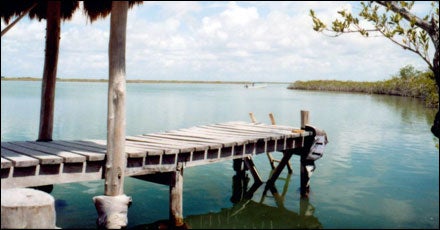It wasn’t hard to convince adventure-travel photographer João Canziani to follow contributing editor Bruce Barcott down the eastern coast of Mexico’s Yucatán Peninsula for the October feature story “The Pleasure’s All Mayan.”
Mexico Photo Gallery
Click here to see more of João Canziani’s photos of Mexico.“Any chance we got we surfed or bodysurfed,” says 33-year-old Canziani, who didn’t hesitate to hand off a camera to his assistant for a cool-down along the white-sand beaches and plush resorts of the Riviera Maya, something he advocates, “as long as you don’t ruin the camera with saltwater.”
Working his way down the Yucatán, hugging the coastline all the way to the border of Belize, Canziani captured images of sea kayakers challenging waves and swimmers diving in underground Cenotes, while rounding up captivating portraits and landscapes indigenous to Mexico.
Born in the coastal city of Lima, Peru, Canziani first got into photography at 14 or 15, after thieves broke into his family’s home and stole, among other things, his father’s camera. As a present, Canziani’s mother bought his father a new one, and, ultimately, it fell to him. “I guess I inherited that Pentax K-1000 by default,” he says. “I felt that it was mine even though it really wasn’t.”
Spending his teenage years sailing and windsurfing ingrained Canziani with a natural love of the water. “I couldn’t possibly survive in a landlocked place,” says the LA-based photographer. “I have to live somewhere that has the ocean.” That kind of fixation, and an almost perpetual readiness for a good road trip, were all the ingredients needed for a successful shoot in Mexico. Although it wasn’t his first time exploring the peninsula, it was an opportunity for Canziani to cover the whole Riviera Maya, an experience he said ranks at the top of his list.
Although transporting equipment can be a hassle, the only way to do justice to an area as large as the Riviera Maya was to do it on the move, says Canziani, who considers himself a “kind of a nomad.”
But it wasn’t all beautiful girls (see page 100 of the October 2006 issue of ���ϳԹ���) and sunny beaches. In fact, to hear him tell it, the mood of the trip seemed to get more and more gloomy as he headed south. Of course the weather undoubtedly played a role in this.
Five minutes after they arrived in Xcalak the sky darkened and it started to rain.”It had this kind of Cape Fear feel,” he says. “Like you were on the edge of the world. You’d think Ernest Hemingway would be there just fishing and there would be nobody else around.” But, being naturally drawn to “the more painterly stuff” and the sense of drama yielded by the absence of light, Canziani welcomed this contrast. “If you see things in the normal daylight it looks one way, but if you see it at night or when it’s cloudy it takes on a different persona,” he says. “I’m attracted to that difference.”
Perhaps where Canziani felt the most removed from “Cancunized” Mexico was at Tulum’s Casa Magna, the renovated former home of Colombian kingpin Pablo Escobar, which now serves as a high-end resort. “Your imagination kind of runs wild about the things that would have been happening at the time,” he says. “We were stepping on his ground.”
To learn more about João Canziani and his work go to .


